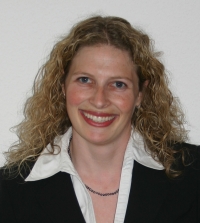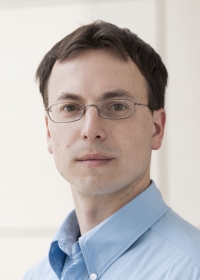

Capillary suspensions are used to specifically adjust the flow behavior of materials and to develop new products, such as inks for printed electronics or microporous ceramics. Such suspensions are studied by a team of scientists under the di-rection of Dr. Erin Koos. The research group headed by Dr. Pavel Levkin focuses on microstructures with hydrophilic and hydrophobic properties for the high-throughput screening of cells. For both projects, KIT has now been awarded an ERC Starting Independent Researcher Grant each.
For a period of five years, the projects will be funded with about EUR 1.5 million each. The Starting Independent Researcher Grant of the European Research Council (ERC) is part of the “Ideas” initiative under the 7th EU Research Framework Programme. It is to support promising projects of young researchers. Starting grants are among the most sought-after funds in Europe. The funds are to be used to establish independent excellent research teams. In 2013, the Starting Grant was awarded for the sixth time. More than 3000 proposals were submitted. Only about one tenth will be funded. KIT scientists also acquired ERC grants in previous rounds.
The research group “Capillary Suspensions: A Novel Route for Ver-satile, Cost-efficient, and Environmentally Friendly Material Design (CapS)” headed by Dr. Erin Koos at the Institute for Mechanical Process Engineering (MVM) of KIT studies novel suspensions for the production of customized, inexpensive, and environmentally friendly materials. Suspensions, i.e. mixtures of a liquid and solids that are finely distributed inside, are the basis of various innovative materials, such as nanotechnological products, coatings, adhesives as well as products used in daily life, e.g. food and cosmetics. The flow behavior of a suspension has to be adjusted precisely to the production method and the desired properties of the product.
So-called capillary suspensions may revolutionize material design: If a small volume of a liquid (less than 1 percent) is added to the continuous phase of a suspension, rheological characteristics are changed. This means that the flow of the suspension is modified. A highly fluid, weakly elastic suspension turns into a gel-like structure with highly elastic properties. With an increasing volume of the phase added, the yield point and viscosity increase by several orders of magnitude. This may be explained by capillary forces between both liquids and the solid. In contact with narrow pipes, gaps, or cavities, liquids exhibit a special behavior that results from the surface tension of the liquids and interfacial tension between the liquids and the solid surface.
By means of capillary suspensions, flow properties can be adjusted specifically, mixtures can be stabilized, phase separation can be avoided, and additives are no longer required. Capillary suspensions are the basis of innovative products, such as inks for printed electronics without conventional polymer or surfactant stabilizers, highly porous, open-pored sintering materials for filters, catalysts, and heat exchangers, plastic films with a small fraction of softeners or low-fat spreads based on water without emulsifiers.
The Helmholtz research group “Chemical Engineering of Biofunctional Materials” headed by Dr. Pavel Levkin from the Institute of Toxicology and Genetics (ITG) of KIT develops a new platform for high-throughput screening of living cells. This means that ten thousands up to millions of genetic, biochemical or pharmacological tests are performed automatically. High-throughput screening accelerates fundamental biological research and the discovery of new medical substances. About half of all high-throughput screenings are assays with living cells. The conventional methods used so far have been associated with a high expenditure and various limitations. The research group of Dr. Pavel Levkin applies novel microstructures for high-throughput screening of cells. These microstructures have both hydrophobic and hydrophilic properties.
So-called superhydrophobic/superhydrophilic microarrays produce highly dense fields of microfine droplets (droplet microarrays) or microfine hydrogel pads (hydrogel microarrays). The new platform combines hydrophilic microfibers, on which finest droplets are formed, with hydrophobic microfibers acting as barriers between the droplets. A tartan-like structure results. On smallest space, many isolated droplets can be arranged in arrays, their size and shape can be adjusted and miniaturized channels can be created. Every droplet acts as a minute three-dimensional test tube, in which the researchers can study the cells under various biochemical impacts.
By means of the platform to be developed, up to 300,000 experiments can be carried out at the same time on a single microarray. Individual cell experiments will take place in completely isolated droplets at certain points of the microarray. Hydrophobic barriers prevent cross-contamination and cell migration. In analogy, a platform for high-throughput screening of cells in 3D hydrogel micropads will be developed.
Erin Koos studied engineering and was awarded her doctorate by the California Institute of Technology with a dissertation on the flow behavior of wet bulk materials. Since 2009, she has been working as a post-doc in the Applied Mechanics (AME) group of the KIT Institute for Mechanical Process Engineering. Her studies focus on capillary forces in suspensions.
Pavel Levkin studied chemistry and chemical engineering at the Moscow Institute of Fine Chemical Technology and received his doctorate at Tübingen University with a dissertation on novel chiral selectors and chiral polymers. He worked as a post-doc at the University of California, Berkeley. Since 2010, he has been heading the Helmholtz University Group “Chemical Engineering of Biofunctional Materials” at the Institute of Toxicology and Genetics (ITG) of KIT and the Chair for Applied Physical Chemistry of Heidelberg University.
In close partnership with society, KIT develops solutions for urgent challenges – from climate change, energy transition and sustainable use of natural resources to artificial intelligence, sovereignty and an aging population. As The University in the Helmholtz Association, KIT unites scientific excellence from insight to application-driven research under one roof – and is thus in a unique position to drive this transformation. As a University of Excellence, KIT offers its more than 10,000 employees and 22,800 students outstanding opportunities to shape a sustainable and resilient future. KIT – Science for Impact.
